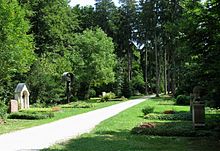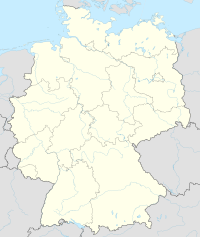Munich Waldfriedhof
 |
|
| Location of Munich Waldfriedhof | |
| Details | |
|---|---|
| Established | 1907 |
| Location | Munich |
| Country | Germany |
| Coordinates | 48°06′10″N 11°29′37″E / 48.102778°N 11.493611°E |
| Type | Public |
| No. of graves | 60,000 |
The Munich Waldfriedhof is one of 29 cemeteries of Munich in Bavaria, Germany. It is one of the larger and more famous burial sites of the city for its park-like design and tombs of notable personalities. The Waldfriedhof is considered the first woodland cemetery.
The Munich Waldfriedhof is located in the southwest and borders several city districts today. It is separated in two sections, the old part and the new part (Alter Teil und Neuer Teil). It holds almost 60,000 graves. The Waldfriedhof is open every day from 8am and closes between 5pm and 8pm depending on the season. During the warmer months of the year the city arranges guided tours. The cemetery is connected to the public transport system MVV by several bus lines. Access to the graves by car is very limited. The cemetery borders the beginning Autobahn A95 in the south as well as other large roads in the north and east.
The Münchner Waldfriedhof as it is called in German was planned by the architect Hans Grässel and opened in 1907. In the years 1963-1966 the cemetery was enlarged by the architect Prof. Ludwig Römer.
The cemetery is one of a series of cemeteries in Munich planned by Grässel at about the same timepoint. The leaders of the city had not been fond of the idea of one huge main cemetery when the old burial sites became too small. Thus Grässel was instructed to plan four new cemeteries, one in each cardinal direction. The Waldfriedhof was created at a time when most cemeteries were designed as city parks or recreational parks. Typical themes of such cemeteries were "the City of the Dead" or "the Paradise Garden". As the new cemeteries were mostly located in the outskirts of cities rather than in churchyards, and the importance of the church was diminishing, they were relatively profane in character. To regain some symbolic strength, Grässel used influences from early Christian and Byzantine architecture in his funeral chapels and other buildings on the cemetery. He also put the burial chapel in the forest, rather than displaying it at the side of the avenue. Grässel kept the trees growing in the area, letting the woods cover tombs in order to create a feeling of connection between nature and death rather than letting the individual monuments be the main feature of the cemetery.
...
Wikipedia

